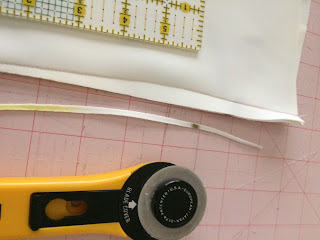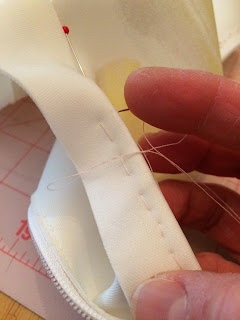I have never sewn with scuba knit and was never tempted to try it until I came across Kathryn Brenne's inspiring tutorial. I fell in love with the fabric she used that I immediately bought myself two yards from Emma One Sock even if I did not have a pattern in mind. I have auditioned several patterns that I thought would be suitable for the fabric. But in the end I reverted back to my truly tried and tested pattern Butterick 5450. I have created five dresses and two tops from this pattern in the past which just goes to show how reliable that pattern is for me!
Fabric
As described in the Emma One Sock website, "this exquisite fabric from Carolina Herrera is beefy with body in the drape, about 15% widthwise stretch, and very stable. The print is a stunning lemony petal cascade with a 32" repeat in tones of lemon with some gray shadings and a creamy white background." Fabric is made of polyester/lycra. This scuba knit fabric behaves more like a woven fabric with minimal stretch. It is also thick like doubleknit.
To have more control of design placement and because the fabric was thick, I laid out my pattern pieces on a single layer of the fabric. I also made sure my rotary cutter had a sharp blade.
Construction
Because of the nature of the fabric (thick and stable), I was able to do away with interfacing and lining. I followed Kathryn Brenne's method of using lapped seams and because the fabric did not ravel, the technique worked wonderfully! Per Kathryn's tutorial, raw edges are exposed on the right side of the garment. One seam overlaps the other and the two are sewn together.
Here are some pictures showing the lapped seam construction:
1. Remove the seam allowance (in this case 5/8") from the overlapping piece. In this case, I removed it from the right overlapping piece. I used a sharp rotary blade cutter and a quilter's ruler for accuracy.
2. Instead of chalking the seam allowance on the underlying piece, I sewed a 5/8" seam guideline because I didn't want to use any colored marking tool on my predominantly white fabric.
3. As shown by the three pictures above, the overlapping piece is pinned to the underlying piece following the sewn guideline. The two layers are then hand basted together.
4. Final stitching involves edgestitching and topstitching.
5. On the wrong side, the excess fabric is trimmed away.
When it was time to sew the bodice to the skirt section, I overlapped the bodice seam.
*Tip: What I have learned from my first experience with lapped seam construction is not to backstitch at the beginning and end. The reason is eventually, when it's time to overlap with another seam, 5/8 of the sewn seam will be cut off and it's better to leave a long tail of thread that can be pulled out before trimming the 5/8. Later, this long tail can be knotted off to secure the seam.
Darts
I did not follow Kathryn's method for treating the dart because it involved cutting it open to the tip and overlapping. She warned that the tip could be a potential weak point and even though extra stitching was suggested to reinforce it, I did not want to risk it.
So I sewed the darts as is.
Then sliced off a sliver of fabric from the center so I could lay the dart sides open.
I basted the dart sides down to keep them flat.

On the right side, I topstitched close to the dart center.
Binding
Since I skipped the bodice lining, I had to finish the neckline and armholes somehow so I followed Kathryn's method of binding.
I cut lengthwise strips of scuba knit 1-1/4" wide and attached them 3/8" from the raw edge of the neckline and armhole on the right side of the fabric.
I wrapped the binding around the edge, turned it over the wrong side and basted before stitching.
I then trimmed the excess fabric from the binding on the wrong side.
Zipper
The pattern calls for a zipper on the left side seam but because I was using an exposed lace zipper, I transferred the zipper opening to the center back.
View of the wrong side.
I used zipper foot to sew zipper.
My zipper was longer than the recommended one so I had to trim it from the bottom edge leaving about 1/2" extra so I could fold it in.
Somehow sewing on the exposed zipper went out without a hitch. Any intersecting seams lined up perfectly right away!
Hem
For the bottom hem, I just folded the hem in and edgestitched then topstitched. I trimmed close to the topstitched edge on the inside.
Additional Tips:
* I used universal size 70 needle and polyester thread for everything including topstitching.
*I used a sharp rotary cutter to cut out my pattern pieces on a single layer of fabric. Aside from the fact that the scuba fabric would be two thick to cut as a double layer, sing a single layer allowed me to have control of design placement.
*I used a walking foot for all construction (except the zipper).
*I used medium length stitches for construction (2.6 using Juki machine) and longer ones for topstitching (3 using Juki machine). During topstitching, I turned down the speed to ensure uniform stitching.
*I used nylon setting with low steam and pressing cloth to press and set my stitches.
So needless to say, this was such a pleasurable sewing experience, mostly because I had a great sewing tutorial to follow.
I also posted a review of this pattern at Pattern Review.com


































Beautiful top! Your construction methods are lovely!
ReplyDeleteThanks Vanessa!
DeleteReally lovely top. The yellow and white print is perfect for spring. The lapped seams are a nice detail but wow, what a lot of extra work they require; trimming, overlapping, hand basting, and top stitching.
ReplyDeleteThanks Audrey! Yeah, it's a lot of work indeed, good thing my top only had a few seams so it wasn't too bad!
DeleteThat is really beautiful. What a lovely sewing job.
ReplyDeleteThanks so much!
DeleteThank you so much for this post, your top looks amazing and professional. For the binding, is it correct that you simply edgestitch the raw edge on the front first, without any folding under you'd do on a traditional bind? If I'm understanding correctly, this is because scuba doesn't fray, so it's ok that the raw edge of the binding is exposed?
ReplyDeleteThank you! Yes, that's correct about the binding. Aside from the fact that my scuba fabric was really thick like a double knit, it does not fray at all.
DeleteDo I add sewing allowance when sewing a scuba fabric
ReplyDeleteAre you using the lapped seam I showed above? If so, and if your pattern already has a built in seam allowance, you will remove the seam allowance only from the piece that will overlap.
Delete